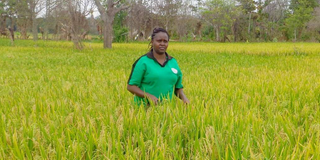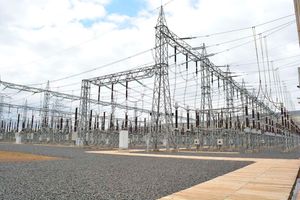Premium
How to profit from rising demand for local rice

Kenya Agricultural and Livestock Research Organisation (Kalro), Mwea Centre Director Dr Ruth Musila on a rice farm.
Dr Ruth Musila is the Kenya Agricultural and Livestock Research Organisation (Kalro), Mwea centre director. She spoke to Irene Mugo on the challenges in the rice sector, how Kalro is working to overcome them and what farmers should do to reap from the growing demand for locally produced rice among consumers.
Kenya has failed to meet its rice demand over the years, importing up to 90 per cent of produce sold in the country. What challenges have led to the current situation and how is Kalro helping to address them?
Farmers are grappling with various challenges, chief among them is the cultivation of low yielding varieties that are susceptible to water stress and diseases such as rice blast, yellow mottle virus that cause severe yield reductions, drought stress due to erratic rainfall resulting to declining water supply for irrigation in the schemes, saline soils, cold damage, flash flooding and submergence of rice fields. There is also use of poor quality seeds, limited access to and slow adoption of proven rice innovations, technologies and management practices, high cost of inputs, limited access to credit and unstructured market linkages.
Kalro has bred improved high-yielding rice varieties with consumer preferred traits – long slender grain, non-sticky rice that separates on cooking, tolerant to water stress, salinity and cold damage and resistant to major rice diseases. So far, we have released eight improved rice varieties for both upland and lowland ecologies namely Komboka, Nerica1, Nerica4, Nerica10, Nerica11, MWUR4, MWIR2 and Duorado precoce. Three more are in the pipeline, namely 08FAN10 (Mkombozi), CO3, CSR36 and Orylux 6. Some of these technologies will be on display during today’s Seeds of Gold farm clinic.
How has climate change become a threat to rice production?
Climate change has caused water scarcity leading to reduced rice yields. Pest incidences have also increased forcing the farmer to dig deeper into their pockets for pesticides and overall increase in the cost of production. Erratic weather patterns have caused farmers harvest and post-harvest losses.
The cost of production has been steadily climbing up yet farm gate prices have stagnated. What can farmers do to survive the situation?
Farmers need to form producer groups and cooperatives to enjoy economies of scale and bargaining power. This will reduce infiltration of the market by brokers. It will also help stabilise the market prices.
There have been efforts to market upland rice varieties with little success. Would you advice farmers to embrace such crops?
Yes, upland rice varieties can help expand rice growing areas. However, for production to pick up, the promotion of these varieties should be accompanied by improved access to milling facilities and organised marketing of produce. Even with small household rice threshers and mills, this can help greatly in expanding rice production in the upland ecology.
How can farmers benefit from Kalro's research on rice?
Adoption of high-yielding improved varieties to double their rice yields and incomes will be of great help. For example, Komboka variety matures in three-and-half to four months, yields 6.5 to 7 tonnes per ha which is significantly more than harvest from local varieties of 2.5 to 3 tonnes per ha and requires less water thus making it suitable for drier areas. In general, purposive adoption of the innovations, technologies and management practices for rice value chain by farmers can help improve their rice yields.
Your last word to farmers planting rice or those seeking to join the trade?
For those planting rice, use certified seeds of high-yielding improved varieties that are preferred by consumers and practice good agronomic practices for higher yields. When in doubt, seek help from extension service providers.
For those seeking to trade in rice, it is a good commercial crop. There is a huge unsatisfied demand for locally produced rice. Acquire the necessary knowledge and information on proper rice production for success.





